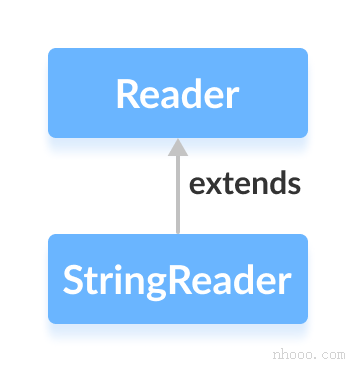Java 菜鸟教程
- Java 菜鸟教程
- Java 开发环境安装
- Java 入门程序
- Java JDK, JRE和JVM
- Java 基本数据类型
- Java 变量类型
- Java 运算符
- Java 输入和输出
- Java 表达式语句
- Java 注释
Java 流程控制
Java 数组
Java 面向对象(I)
- Java 类和对象
- Java 方法
- Java 构造函数
- Java 修饰符
- Java 字符串(String)
- Java this 关键字
- Java final 关键字
- Java instanceof 关键字
- Java 递归
Java 面向对象(II)
Java 面向对象(III)
- Java 嵌套和内部类
- Java 嵌套静态类
- Java 匿名类
- Java 单例模式
- Java 枚举(Enum)
- Java 枚举构造函数
- Java 枚举与字符串
- Java 反射(Reflection)
- Java 包(package)
Java 异常处理
- Java 异常(Exceptions)
- Java 异常处理
- Java throw和throws 关键字
- Java 处理多个异常
- Java try-with-resources
- Java 注解(Annotations)
- Java 日志(Logging)
- Java 断言(Assert)
Java 列表(List)
Java Queue(队列)
Java Map集合
Java Set集合
Java 输入输出(I/O)
Java Reader/Writer
Java 其他主题
Java StringReader 类
在本教程中,我们将借助示例学习Java StringReader及其方法。
java.io包的StringReader类可用于从字符串读取数据(以字符为单位)。
它继承了抽象类Reader。

注意:在StringReader中,指定的字符串充当源,从其中分别读取字符。
创建一个StringReader
为了创建一个StringReader,我们必须首先导入java.io.StringReader包。导入包后,就可以创建字符串读取器了。
//创建 StringReader StringReader input = new StringReader(String data);
在这里,我们创建了一个StringReader,它从指定的名为data的字符串中读取字符。
StringReader的方法
StringReader类为Reader类中的不同方法提供了实现。
read()方法
read() - 从字符串读取器读取单个字符
read(char[] array) - 从阅读器读取字符并将其存储在指定的数组中
read(char[] array, int start, int length) - 从阅读器读取等于length字符的数量,并从start位置开始存储在指定的数组中
示例:Java StringReader
import java.io.StringReader;
public class Main {
public static void main(String[] args) {
String data = "This is the text read from StringReader.";
//创建一个字符数组
char[] array = new char[100];
try {
//创建一个StringReader
StringReader input = new StringReader(data);
//使用read方法
input.read(array);
System.out.println("从字符串读取数据:");
System.out.println(array);
input.close();
}
catch(Exception e) {
e.getStackTrace();
}
}
}输出结果
从字符串读取数据: This is the text read from StringReader.
在上面的示例中,我们创建了一个名为input的字符串读取器。 字符串阅读器链接到字符串数据(data)。
String data = "This is a text in the string."; StringReader input = new StringReader(data);
为了从字符串中读取数据,我们使用了read()方法。
在此,该方法从阅读器读取字符数组,并将其存储在指定的数组中。
skip()方法
要丢弃和跳过指定数量的字符,可以使用skip()方法。例如
import java.io.StringReader;
public class Main {
public static void main(String[] args) {
String data = "This is the text read from StringReader";
System.out.println("原始数据: " + data);
//创建一个字符数组
char[] array = new char[100];
try {
//创建 StringReader
StringReader input = new StringReader(data);
//使用 skip() 方法
input.skip(5);
//使用 read 方法
input.read(array);
System.out.println("跳过5个字符后的数据:");
System.out.println(array);
input.close();
}
catch(Exception e) {
e.getStackTrace();
}
}
}输出结果
原始数据: This is the text read from the StringReader 跳过5个字符后的数据: is the text read from the StringReader
在上面的示例中,我们使用skip()方法从字符串读取器中跳过5个字符。因此,字符'T'、'h'、'i'、's'和' '从原始字符串读取器中被跳过。
close()方法
要关闭字符串阅读器,我们可以使用该close()方法。调用close()方法后,我们将无法使用读取器从字符串读取数据。
StringReader的其他方法
| 方法 | 描述 |
|---|---|
| ready() | 检查字符串读取器是否准备好被读取 |
| mark() | 标记读取器中已读取数据的位置 |
| reset() | 重置标记,返回到阅读器中设置标记的位置 |